甲状腺激素和抗甲状腺药Thyroid
甲状腺激素及抗甲状腺药

不良反应与注意事项 1、过敏反应 2、消化道反应 3、粒细胞缺乏症 4、甲状腺肿及甲状腺功能减退
二、碘及碘化物
复方碘溶液(liguor iodine Co)(卢戈液Lugol, s solution)
药理作用及临床应用
不同剂量的碘对甲状腺产生不同作用。
1、小剂量碘促进甲状腺激素合成,预防单纯性 甲状腺肿
安全象只弓,不拉它就松,要想保安 全,常 把弓弦 绷。20.12.2008:16:3008:16Dec-2020-Dec-20
加强交通建设管理,确保工程建设质 量。08: 16:3008:16:3008:16Sunday, December 20, 2020
安全在于心细,事故出在麻痹。20.12.2020.12.2008: 16:3008:16:30Decem ber 20, 2020
甲状腺激素及抗甲状腺药
甲状腺激素是维持机体正常代谢、促进 生长发育所必须的激素,分泌过多或过 少可引起甲亢或甲减。
甲状腺激素包括甲状腺素和三碘甲状腺 原氨酸
第一节——甲状腺激素 (Thyroid hormones)
构效关系 甲状腺激素的合成、贮存、分泌与调节 1、碘的摄取 2、碘的活化(活性碘)和酪氨酸碘化(一
每天都是美好的一天,新的一天开启 。20.12.2020.12.2008: 1608:16:3008: 16:30Dec-20
务实,奋斗,成就,成功。2020年12月20日 星期日8时16分 30秒Sunday, December 20, 2020
抓住每一次机会不能轻易流失,这样 我们才 能真正 强大。20.12.202020年 12月20日星期 日8时16分30秒20.12.20
1、改善甲亢所致的心脏交感神经功能增强 的表现
甲状腺激素及抗甲状腺药复习

体内过程
生物利用度 作用 半衰期 脂溶度 吸收
T3
90-95% 快、强 1天 高 好
T4
50-70% 弱、长 6-8天
高 好
• 可通过胎盘和乳汁,妊娠和脯乳期应注意不用。
地方性甲状腺肿的主要原因是碘缺乏,所以又
分泌过多---心悸、出汗、进食和便次增多和体重减少的病症。多数患 者还常常同时有突眼、眼睑水肿、视力减退等症状------功能亢进;
---手术、抗甲状腺药。
制剂来源:
1.甲状腺粉:T3有活性,T4在外周组织中脱碘后转化为T3 2. 人工合成: T3碘赛罗宁:作用强大、起效快、维持时间短。 T4左甲状腺素:作用温和、起效慢、作用维持时间久。
大剂量:抗甲状腺
①抑制甲状腺球蛋白(TG )水解,从而抑制甲状腺激素的释放;
② 拮抗TSH的促进激素释放作用;
③抑制甲状腺过氧化物酶活性,抑制酪氨酸碘化和碘化酪氨酸偶联;
特点:作用快而强,2-7天起效,10-15天达最大效应。
不可用于甲亢内科治疗:当腺泡细胞内碘浓度达一定程度,细胞摄碘功能
降低,胞内碘离子浓度下降,失去抑制激素合成的效应。
甲状腺激素的合成、贮存、释放、调节:
• 碘:甲状腺中含全身总量的90%,为血浆中的25-50倍,甲亢时可达250倍
1)碘摄取:I-(泵)→摄入甲状腺腺泡内,某些物质可影响其转运,如硫 氰酸盐、溴化物等; 2)碘活化和酪氨酸碘化:I-过氧化物酶→活性I-或中间产物→与甲状腺球 蛋白(TG)中的酪氨酸残基结合→ MIT(一碘酪氨酸)、DIT(二碘酪氨酸); 3)偶联:过氧化物酶作用下的偶联:MIT +DIT=T3,2DIT=T4→T3、T4结 合于TG贮存于滤泡腔中; 4)释放:偶联物-蛋白水解酶-T4(90%,36%转化为T3)、T3(活性为T4 的5倍)-释放入血;
甲状腺激素及抗甲状腺药
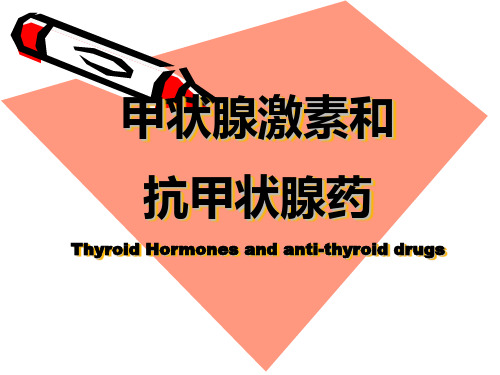
一、甲状腺激素分类
甲状腺激素
T4(甲状腺素) 四碘甲状腺原氨酸
T3 三碘甲状腺原氨酸
含量高
作用弱而持久
含量少
作用快而强
二、构效关系
3 4 2 1 6
5
酪氨酸
二、合成、贮存、分泌、调节
1、合成过程: ①碘摄取 ②碘活化、酪氨酸碘化
③耦联
摄 取
• 甲状腺含碘量占全身总量的90% – 碘泵聚碘(主动摄取,耗能) – 激活碘泵的物质:TSH – 抑制碘泵的物质:
二、碘及碘化物
【药理作用】
1、小剂量的碘可以促进甲状腺激素的合成。治疗单纯性 甲肿,一般在食盐中添加以预防甲肿。
2、大剂量产生抗甲状腺作用,抑制释放及合成,起效快 作用强。10-15d达最大效应时不宜继续用药,否则抑制碘 摄取,降低胞碘浓度,失去抑制合成的作用。故不能单独 用于甲亢治疗。
• 抑制TPO,影响T3、T4合成
• 抑制TG水解酶,抑制T3、T4释放 • 抑制TSH释放,使增生的甲状腺血流供应减少,减少充血,使 腺体变硬、变小。(抑制谷胱甘肽还原酶,妨碍T3T4与甲状腺球蛋
白水解,最后抑制释放,长期应用则失效)
4、甲状腺激素合成和分泌的调节
应激、温度变化、 病理状态通过TRH 影响甲状腺功能
血T3、T4浓度通 过负反馈调节 TSH和TRH释放
【药理作用】 (重点)
三方面 • 维持正常生长发育 • 促进代谢和产热 • 增强交感神经系统的活性,并提高机体 对儿茶酚胺类的敏感性
1.维持正常的生长发育 原因:
抑制
大剂量碘
【体过程】
口服吸收迅速,生物利用度约为80%,甲状腺浓集多, 易进入乳汁、通过胎盘,肝内代谢;卡比马唑需在体 内转化为甲巯咪唑而发挥作用,故不宜用于急症。
甲状腺激素及抗甲状腺药

甲状腺激素
【临床应用】
3.其他
①甲亢 服用抗甲状腺药,加服T4 目的:减轻服用抗甲状腺药后的突眼、甲状腺肿大
防止甲状腺功能低下等。
甲亢孕妇不加用T4 原因:T4不易通过胎盘屏障
不能防止抗甲状腺药剂量过大对胎儿甲状腺的影响
甲状腺激素
【临床应用】
3.其他
①甲亢 ②甲状腺癌术后
目的:抑制残余甲状腺癌变组织,减少复发; 用量需较大;
甲状腺激素
【作用机制】
1.甲状腺激素受体(thyroid hormone receptor,TR) 作用:介导甲状腺激素; 表达:垂体、心、肝、肾、骨骼肌 肺、肠等组织; 分布:主要在细胞核内; 结构:两个受体蛋白构成的二聚体能与 DNA结合,分子量52kDa;
甲状腺激素
【作用机制】
2.基因作用:
两个垂直相连的苯环 环Ⅰ:带羧基的侧链; 环Ⅱ:酚羟基;
甲状腺激素
【构效关系】
3.参与与受体的结合
环Ⅰ3位和5位的碘
4.妨碍和受体结合
环Ⅱ5’→活性下降
5.外周转换
T4的5’位经脱碘反应
活性更强的T3;
环Ⅰ5 位脱碘
无活性的反向T3(reverseT3,rT3)
甲状腺激素
酚羟基
羧基酸等摄入细胞内 →多种酶和细胞活性增强
甲状腺激素
【临床应用】
主要用于甲状腺功能低下的替代疗法。
1.甲状腺功能低下 ①呆小病:功能减退始于胎儿或新生儿
小剂量,逐渐增加剂量 有效者应终身治疗 随时调整剂量;
甲状腺激素
【临床应用】
1.甲状腺功能低下
②黏液性水肿
小剂量,逐渐增加至足量, 2~3周后基础代谢率恢复正常,逐减至维持量 老年及心血管病者增量宜缓慢,防止诱发或加重心脏病变 垂体功能低下:宜先用糖皮质激素,
33甲状腺激素与抗甲状腺药案例版 ym

常用药物特点比较
药物
甲硫氧嘧啶 丙硫氧嘧啶 甲巯咪唑
卡比马唑
作用特点
作用确定,起效缓慢
作用确定,起效快,甲状腺危象疗效 好 作用较硫氧嘧啶类强10倍,起效亦缓 慢,但持久,甲状腺危象治疗不如丙 硫氧嘧啶 作用缓慢、持久,甲状腺危象不宜用
二、碘和碘化物
碘化钾(potassium iodide) 碘化钠(potassium iodate) 复方碘溶液(compound iodine
2、良反应及注意事项
• 易致甲状腺功能低下,补甲状腺激素对抗。 服131I前2~4周应避免用碘剂及其他含碘食 物。
• 131I禁用于妊娠甲亢、儿童甲亢及重症甲亢 患者。
41
四、-R阻断药
1、阻断-R 控制交感兴奋症状 2、减少甲状腺激素分泌 3、抑制外周T4转变为T3
① 配合抗甲状腺药物使用
② T3 抑制试验:
单纯性甲状腺肿:摄碘率↓﹥50%
甲亢: 摄碘率↓﹤50%
22
[不良反应]
过量引起甲亢 心悸、多汗、手震颤、神经过敏、失眠
老年和心脏病者 可发生心绞痛、心肌梗塞和心力衰竭
禁用于:高血压、冠心病和快速型心律失常
24
第二节 抗甲状腺药
硫脲类 碘化物 放射性碘 β-肾上腺素受体阻断药
关于“醉翁”与“六一居士”:初谪滁山,自号醉翁。既老而衰且病,将退休于颍水之上,则又更号六一居士。客有问曰:“六一何谓也?”居士曰:“吾家藏书一万卷,集录三代以来金石遗文一千卷,有琴一张,有棋一局,而常置酒一壶。”客曰:“是为五一尔,奈何?”居士曰:“以吾一翁,老于
此五物之间,岂不为六一乎?”写作背景:宋仁宗庆历五年(1045年),参知政事范仲淹等人遭谗离职,欧阳修上书替他们分辩,被贬到滁州做了两年知州。到任以后,他内心抑郁,但还能发挥“宽简而不扰”的作风,取得了某些政绩。《醉翁亭记》就是在这个时期写就的。目标导学二:朗读文章,通
6.2 甲状腺激素及抗甲状腺药

甲状腺激素和抗甲状腺药本章内容1、甲状腺激素(Thyroid Hormone)2、抗甲状腺药(Antithyroid Drugs)分类(1)硫脲类(Thioureas)硫氧嘧啶类:甲硫氧嘧啶;咪唑类:甲巯咪唑,卡比马唑。
(2)碘及碘化物(iodine & iodide):复方碘溶液放射性碘(Radioiodine):131Iβ受体阻断药:普萘洛尔甲状腺激素基本结构单位:甲状腺腺泡;上皮细胞:强大的摄碘功能合成甲状激素;腺泡腔:内为胶质,储存甲状腺激素。
上皮细胞胶质甲状腺激素合成、贮存、释放甲状腺激素的药理作用1. 维持正常生长发育促进蛋白质合成促进骨吸收和骨形成神经系统骨骼发育智力↓身高↓ 儿童甲状腺激素↓ →呆小症粘液性水肿中枢兴奋性↓记忆力减退成人甲状腺激素↓2. 促进代谢促进物质氧化增加耗氧提高基础代谢率甲亢怕热、多汗消瘦、乏力易饥饿甲状腺激素的药理作用产热增加甲低→BMR↓,怕冷3. 神经系统及心血管效应:维持中枢神经发育:呆小症智力发育障碍。
增强对儿茶酚胺敏感性,上调肾上腺素能受体。
甲亢:情绪激动,失眠,心悸,血压增高甲状腺激素的临床应用临床应用【临床应用】甲状腺功能低下的替代补充疗法。
1.呆小症胎儿或幼儿:小量开始,终身治疗。
2. 黏液性水肿小量开始,逐渐增加至足量垂体功能低下:宜先给糖皮质激素,再用甲状腺制剂。
,苏黏液性水肿昏迷:静注大剂量L-T4醒后口服。
3. 单纯性甲状腺肿缺碘—补碘无明显原因—适量甲状腺激素。
【不良反应】甲状腺功能亢进症状:宜用β受体阻断剂对抗,减量或停用甲状腺激素。
抗甲状腺药物可用以治疗甲状腺功能亢进,暂时或长期控制甲亢症状的药物统称抗甲状腺药。
常用的药物有:1、硫脲类(Thioureas):硫氧嘧啶类:甲硫氧嘧啶;咪唑类:甲巯咪唑,卡比马唑。
2、碘(iodine)及碘化物(iodide) :复方碘溶液。
3、放射性碘(Radioiodine):131I。
甲状腺激素和抗甲状腺药(Thyroid Hormones and Antithyroid Drugs)

一. 硫脲类(Thioreas)
硫氧嘧啶类(thiouracils)
甲硫氧嘧啶
丙硫氧嘧啶
咪唑类(imidazoles)
甲巯咪唑(他巴唑) 卡比马唑(甲亢平)
(一) 药理作用机制
1. 抑制甲状腺激素合成 ①过氧化物酶, 酪氨酸的碘化和耦联反应 ②对已经合成的甲状腺激素无效 2. 抑制T4转化为T3 在外周组织内抑制T4转化为T3 3. 减弱β受体介导的糖代谢 4. 免疫抑制作用 使血中甲状腺刺激性免疫球蛋白(TSI)含量
一.甲状腺激素类的构效关系
二.甲状腺激素的合成、贮存、分泌与调节
1. 2.
碘的摄取:
甲状腺腺泡细胞通过碘泵主动摄碘及浓集碘
碘的活化和酪氨酸碘化:
碘化物 活性碘 生成MIT,DIT 与甲状腺球蛋白酪氨酸残基结合
3. 4. 5.
耦联:
DIT + MIT T3 ; 2 DIT T4
释放:
经蛋白水解酶水解后将TG中的T3、T4释放入血
3. 不良反应
⑴一般反应:上呼吸道刺激等。
⑵过敏反应: ⑶诱发甲状腺功能紊乱:
三、放射性碘 ( Radioiodine )
⒈ 药理作用机制
β射线损伤甲状腺实质
⒉ 临床应用
⑴甲状腺功能亢进治疗
⑵甲状腺摄碘功能测定:
甲亢时摄碘率高,摄碘高峰时间前移
甲减时摄碘率低,摄碘高峰时间移后
四、β肾上腺素受体阻断药 ⒈药理作用机制 控制交感神经活性增强所致症状 适当减少T3、T4分泌 减少T3、r T3的生成 ⒉临床应用 甲亢、甲亢危象辅助治疗和甲亢术前准备
3. 主要在肝、肾线粒体内脱碘,并与葡萄糖醛酸 或硫酸结合而经肾排泄。甲状腺激素可通过胎 盘和进入乳汁、妊娠和哺乳期应注意。
甲状腺激素及抗甲状腺药Thyroidhormonesandantithyroid
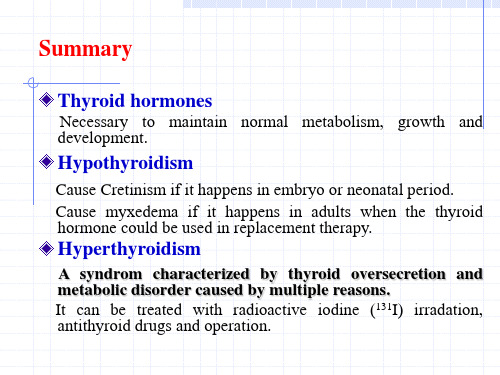
blood after hydrolyzed by proteases .At the same time , some of them can be turned back to tyrosine and I- by deiodinase in cells and reused.
Summary
Thyroid hormones
Necessary to maintain normal metabolism, growth and development.
Hypothyroidism
Cause Cretinism if it happens in embryo or neonatal period. Cause myxedema if it happens in adults when the thyroid hormone could be used in replacement therapy.
Physiological disposition of thyroid hormones
Absorbed rapidly when take orally , activity T3>T4,
maintaining time T4>T3. T1/2 of T4 and T3 are 6-7 days and 1-2 days, respectively.
Thyroid hormones
Thyroxine, T4 Triiodothyreninum natricum, T3
Synthesized and secreted by thyroid
甲状腺激素 PPT课件

四、受体阻断药
【药理作用】
阻断β 受体而改善甲亢所致的症状,也
减少 甲状腺激素的分泌 【临床应用】 辅助治疗甲亢患者及甲状腺危象 【不良反应】 对心血管系统和气管平滑肌等的反应
不良反应
过量→甲亢表现, 诱发 心绞痛 与 心肌梗塞
第二节 抗甲状腺药物
常用药有: 硫脲类、 碘化物、 放射性碘 β受体阻断药
攝碘 碘化及耦合
释放
一、硫脲类
硫氧嘧啶: 甲硫氧嘧啶(Methylthiouracil) 丙硫氧嘧啶(Propythiouracil) 咪唑类: 甲硫咪唑(Thiamazole,他巴唑) 卡比马唑(Carbomazole,甲亢平)
体内过程
口服吸收迅速,生物利用度约80% 甲巯咪唑的T1/2为4.7h,但在甲状腺组织 中可维持16~24h,每日给药一次(30mg) 与每日给药三次(10mg)疗效相似
药理作用
1、抑制T3、T4合成 抑制过氧化物酶
• 抑制I的氧化; • 抑制酪氨酸I化成MIT及DIT; • 抑制IMT及DIT缩合成T3及T4
三、放射性碘
I131作用:
β射线: 占99%,射程2mm, 仅破坏甲状腺实质 γ射线:占1%,用于甲状腺摄I 功能测定
应用
甲亢治疗: 适用于不宜手术或手术后复发,及硫脲类无效 或过敏者 甲状腺功能检查: 甲亢:摄碘率↑,高峰前移 甲低:摄碘率↓,高峰后延 不良反应: 甲低(补充甲状腺激素) 20岁以下病人、妊娠或哺乳的妇 女及肾功不佳者不宜使用
碘泵主动摄取血液中的碘化物
I2氧化成I* 过氧化物酶 酪氨酸碘化 活性I*与酪氨酸缩合MIT,DIT 过氧化物酶 2个酪氨酸缩合 MIT+DIT T3,T4(1:4)
甲状腺激素全

一 .甲状腺激素 (Thyroid hormones,TH) 二 .甲状腺激素的药理作用 三 .甲状腺激素的应用 四 .抗甲状腺药
甲状腺激素
� 人的甲状腺重20~30g,是人体内最大的内 分泌腺。它位于气管上端两侧,甲状软骨的 的下方,分为左右两叶,中间由较窄的峡部 相联,呈“H”形。
作用特点:
� 不影响碘的摄取和已合成的甲状腺激素的作用 � 只影响甲状腺激素的合成,不影响其释放 � 一般用后 2~3W症状改善 ,1~3个月基础代谢率
恢复正常。 � 久用后致腺体增大、充血:因TSH反馈性 。
【 体内过程 】
1. 硫氧嘧啶 口服吸收迅速,服药后 2h血药浓度达峰 值,生物利用度为 80%,体内分布广,主要在肝脏 内代谢, t1/2为2h。
环Ⅰ3位和5
位的碘参与
I
I
受体的结合。
3'
3
O
CH2CHCOOH
5'
I( Ⅱ环)
5
I(Ⅰ环) NH2 环Ⅰ5位脱碘
甲状腺素(T4)
可变为无活性
的反向T3
I 3'
HO 5'
I
3
O
5
I
I
3'
CH2CHCOOH HO
NH2
5'
I
I
3
O
5
CH2CHCOOH NH2
三碘甲状腺原氨酸(T3)
反式三碘甲状腺原氨酸(rT3)
一、硫脲类(thioureas)
历史 甲状腺肿形成的机制的研究始于观察到饲以卷心菜 的家兔经常出现甲状腺肿,主要是由于卷心菜中有硫氰酸 离子的前体。后来发现磺胺脒和苯硫脲可造成甲状腺肿, 他们的初始作用是抑制甲状腺激素的合成。
甲状腺激素及抗甲状腺药
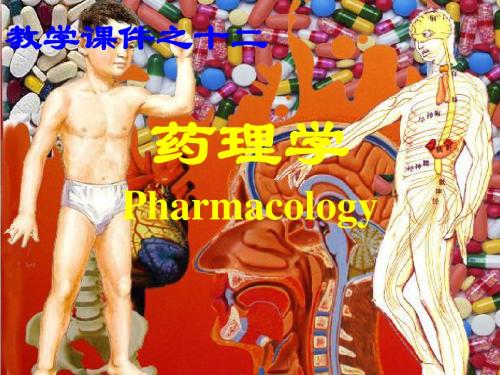
6
MIT: MIT:一碘酪氨酸 DIT: DIT:二碘酪氨酸 TG:甲状腺球蛋白 TG:
下丘脑 TRH 垂体 TSH
甲状腺细胞
Байду номын сангаас
血 滤 蛋白血液 过氧化 液 碘泵 过氧化物酶 MIT 物酶 T3 泡 水解酶 T3 腔 II0 中 DIT T4 胶 T4 I TG上的酪 上的酪
质 氨酸残基
7
【生理药理作用】 生理药理作用】 1. 调控生长发育:促进蛋白质合成及骨骼和CNS的 调控生长发育:促进蛋白质合成及骨骼和CNS的 生长发育(尤其骨骼、脑和生殖器官, 生长发育(尤其骨骼、脑和生殖器官,出生后头 四个月影响最大) 分泌不足: 四个月影响最大)。 T3 、T4分泌不足:婴幼儿引 起呆小病(克汀病),成人可致粘液性水肿。 ),成人可致粘液性水肿 起呆小病(克汀病),成人可致粘液性水肿。 2. 促进代谢和产热:促进物质氧化,使耗氧量↑, 促进代谢和产热:促进物质氧化,使耗氧量↑ 基础代谢率升高、产热量增多。 基础代谢率升高、产热量增多。 3. 对心血管和神经系统的影响:提高机体对儿茶酚 对心血管和神经系统的影响: 胺的敏感性,维持正常功能,提高神经兴奋性。 胺的敏感性,维持正常功能,提高神经兴奋性。 T3 、T4分泌过多→甲亢 分泌过多→
12
2. 黏液性水肿:剂量大 黏液性水肿: 小依据病情轻重和病程 长短而定。 长短而定。
3. 单纯性甲状腺肿:缺碘者 单纯性甲状腺肿: 补碘, 补碘,其他的可给予适量甲 状腺片,以补充T 状腺片,以补充T3、T4的不 并抑制TSH过多分泌 过多分泌。 足,并抑制TSH过多分泌。
13
【不良反应】 不良反应】 1.过量引起甲状腺功能亢进 1.过量引起甲状腺功能亢进 有心悸、多汗、手震颤、神经过敏、 有心悸、多汗、手震颤、神经过敏、失眠 等症状。严重时出现腹泻,呕吐, 等症状。严重时出现腹泻,呕吐,脉搏快不 规则,甚至心绞痛,心力衰竭,肌肉震颤, 规则,甚至心绞痛,心力衰竭,肌肉震颤, 一旦发生,立即停药, 受体阻断剂对抗。 一旦发生,立即停药,用β受体阻断剂对抗。 2. 老年和心脏病者可发生心绞痛、心肌梗塞和心 老年和心脏病者可发生心绞痛 可发生心绞痛、 力衰竭。 力衰竭。 3. 糖尿病、冠心病、快速型心律失常禁用。 糖尿病、冠心病、快速型心律失常禁用。
甲状腺激素及抗甲状腺药
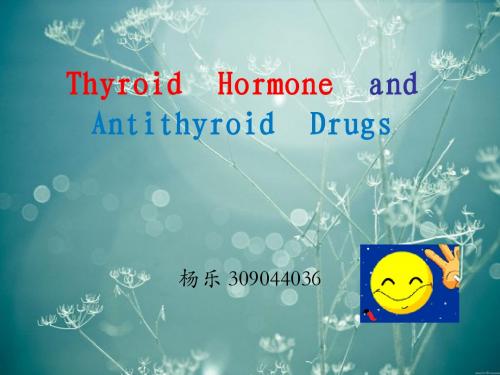
Thyroid Hormone
Thyroid hormone 是由甲状腺腺泡 中的甲状腺球蛋白经碘化、耦联 而成的。其结构较为独特,在其 结构中均含有无机碘。以醚键或 硫醚键相连的两个苯环相互垂直!
原料: 酪氨酸--人体自行合成 碘--食物供应
I HO O
I CH2CHCOOH I
NH2
I
三碘甲状腺原氨酸(T3)
【不良反应】发生率3~12%。丙硫氧嘧啶、 甲巯咪唑少;甲硫氧嘧啶较多。 1、过敏反应:皮疹,瘙痒,发热,少数可见 剥脱性皮炎。 2、甲状腺肿或甲状腺功能减退: 3、消化道反应:厌食,呕吐,腹痛,腹泻。 4、白细胞减少和粒细胞缺乏。
Antithyroid Drugs -- iodine & iodide
Antithyroid Drugs -- thioureas
丙硫氧嘧啶片
Dr. Herbrand KG, Chem.-Pharm. Works
【药理毒理】 抗甲状腺药物。其作用 机理是抑制甲状腺内过氧化 物酶,从而阻止甲状腺内酪 氨酸碘化及碘化酪氨酸的缩 合,从而抑制甲状腺素的合 成。同时,在外周组织中抑 制T4变为T3,使血清中活性 较强的T3含量较快降低。
2、促进代谢和产热:
促进物质氧化,增加氧耗,提高基础代谢率,使产热增多。成人甲状腺功能不全 时,病人怕冷,其他代谢活动也低,严重时可引起粘液性水肿(myxedema)。
基础代谢率(BMR),产热 甲状腺功能亢进:怕热,多汗; 甲状腺功能低下:粘多糖沉积黏液性水肿
3、 提高交感-肾上腺素系统敏感性:
药理作用
硫脲类抗甲状腺药物。其作用机制是抑制甲状腺内过氧化物酶,从而阻碍吸聚以甲状腺内 碘化物的氧化及酪氨酸的偶联,阻碍甲状腺素(T4)和三碘甲状腺原氨酸(T3)的合成。 动物实验观察到可抑制B淋巴细胞合成抗体,降低血循环中甲状腺刺激性抗体的水平,使抑 制性T细胞功能恢复正常。
甲状腺及抗甲状腺素药ppt课件

甲状腺激素—作用机制
通过激活其核特异性T3受体所介导。 在细胞内T4经脱碘转化成T3后进入细胞核, 与特异性T3受体结合,调节基因转录,影响 蛋白质合成而发挥效应。
许多因素可影响T3受体数目使其数目减少。
甲状腺激素—临床应用
呆小病 功能减退始于胎儿或新生儿,若尽早诊
治,则发 育仍可正常。
慢性碘中毒 表现为口腔及咽喉烧灼感、唾液 分泌增多,眼刺激症状等。
诱发甲状腺功能紊乱 长期服用碘化物可诱发 甲亢。碘还可进入乳汁并通过胎盘引起新生儿甲 状腺肿,孕妇及乳母慎用 。
放射性碘 — 【药理作用】
临床应用放射性碘是131I,t1/2为8.1d
甲状腺有高度摄碘能力,131I可被甲状腺摄取, 并可产生β射线(99%),其在组织内射程仅 约2 mm,因此其辐射作用只限于甲状腺内, 破坏甲状腺实质,而很少波及周围组织。
与TG上的酪 aa残基结合
硫脲类—体内过程
硫氧嘧啶类药物 口服吸收迅速,20~30 min起 效,2 h血药浓度达峰值,吸收率为80%。血浆蛋 白结合率约75%,分布于全身各组织,以甲状腺 浓集较多,能通过胎盘,易进入乳汁,主要经肝
代谢灭活,t1/2约2 h。 甲巯咪唑 (他巴唑)作用较慢而持久,血浆t1/2
放射性碘 —不良反应
剂量过大易致甲状腺功能低下,一旦发生可 补充甲状腺激素对抗,服131I前2~4周应避 免用碘剂及其他含碘食物。 131I禁用于妊娠甲亢、儿童甲亢及重症甲亢 患者。
β受体阻断药
作用机制
主要通过阻断β受体,减轻甲亢患者交 感—肾上腺系统兴奋症状,此外,还可抑 制甲状腺激素分泌及外周组织T4 脱碘成为 T3。
临床应用
用于控制甲亢症状、甲亢术前准备 及甲状腺危象的辅助治疗。若与硫脲类合 用则疗效更佳。
36-37甲状腺-胰岛素
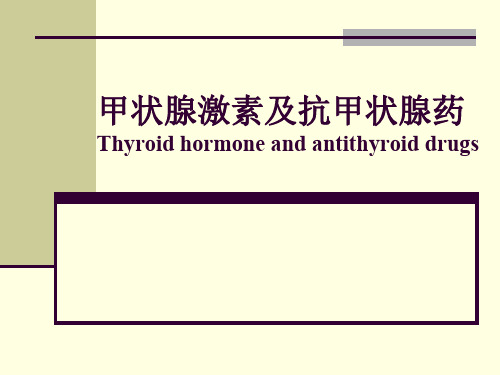
发及硫脲类无效或过敏者,作用缓慢,一般用 药1个月见效,3-4个月后甲状腺功能可恢复正 常
甲状腺摄碘功能检查
不良反应
剂量过大易致甲状腺功能低下
大纲
抗甲状腺药 (1)硫脲类的药理作用、临床应用及不良反应 (2)碘及碘化物的药理作用、临床应用及不良
反应
T4作用慢而弱,维持时间长
甲状激素的生理作用
甲状腺激素的主要作用是促进物质与能 量代谢,促进生长和发育过程 对代谢的影响 产热效应:促进物质氧化,增加耗氧, 提高基础代谢率,使产热和散热增多 对蛋白质、糖和脂肪长发育的影响
具有促进组织分化、生长与发育成熟的作用
药理作用
钾离子转运:激活Na+-K+- ATP酶,K+内流增 加,胞内K+浓度增加。
应用:临床上常将葡萄糖、胰岛素及氯化钾制 成极化液(GIK)静脉滴注,用以纠正细胞内 缺钾
加快心率,加强心肌收缩力和减少肾血流
作用机制
作用机制
注射用普通胰岛素的临床应用
IDDM 非胰岛素依赖型糖尿病经饮食控制
Ⅱ
Ⅰ
T4
T3
Ⅱ
Ⅰ
rT3
Ⅱ
Ⅰ
第一节 甲状腺激素(thyroid hormone)
甲状腺激素的合成与代谢 1. 甲状腺腺泡聚碘 2. 碘的活化 3. 酪氨酸碘化 4. 耦联 5. 释放
甲状腺激素的生物合成
甲状腺激素的调节
体内过程
吸收:口服易吸收 分布:入血后绝大部分与甲状腺结合蛋
白结合 代谢:肝代谢 排泄:肾排泄 特点:T3作用快而强,维持时间短
药物本身作为过氧化物酶的底物被氧 化,影响酪氨酸的碘化和耦联,从而抑制 甲状腺激素的生物合成。 特点:对已合成的甲状腺激素无效
- 1、下载文档前请自行甄别文档内容的完整性,平台不提供额外的编辑、内容补充、找答案等附加服务。
- 2、"仅部分预览"的文档,不可在线预览部分如存在完整性等问题,可反馈申请退款(可完整预览的文档不适用该条件!)。
- 3、如文档侵犯您的权益,请联系客服反馈,我们会尽快为您处理(人工客服工作时间:9:00-18:30)。
Promote metabolism and increase heat production
Promote oxidation, increase oxygen consumption, basal metabolic rate and heat production.
Elevate sensitivity of sympathetic - adrenal system
Synthesis, storage and regulation of thyroid hormones Iodine uptake Iodine activation and tyrosine iodation Condensation and storage Disintegration and release Regulation
硫脲类
• • • •
硫氧嘧啶类( 硫氧嘧啶类(thiouracil): ) 甲基硫氧嘧啶(methykthiouracil) 丙基硫氧嘧啶(propylthiouracil) 咪唑类( 咪唑类(imidazoles) ) 他 巴 唑 ( Tapazole , 甲 巯 咪 唑 methimazole) 甲亢平(卡比马唑Carbimazole)
Steps of thyroid hormones synthesis, release and regulation (Ⅱ) Ⅱ
Condensation and storage: In the thyroid globulin
molecule , two DTTs are condensed to T4 , one DTT and one MIT are condensed to T3,which are all stored in gland , alveolus colloid . Disintegration and release: T3 and T4 are released into blood after hydrolyzed by proteases .At the same time , some of them can be turned back to tyrosine and I- by deiodinase in cells and reused. Regulation: By the positive and negative feedback regulation of hypothalamus-anterior lobe-thyroid axis. Hypothalamus secrets TRH ,anterior lobe secrets TSH and thyroid synthesize T3 , T4.
Thyroid hБайду номын сангаасrmones
Thyroxine, T4 Triiodothyreninum natricum, T3
Synthesized and secreted by thyroid
抗甲状腺药
分为4类 分为 类: 硫脲类 Thiourea 碘和碘化物 (复方碘溶液, lugol’s solution) ) 放射性碘(131I) β受体阻断药(心得安等从略)
Hypothyroidism
Cause Cretinism if it happens in embryo or neonatal period. Cause myxedema if it happens in adults when the thyroid hormone could be used in replacement therapy.
甲状腺激素和抗甲状腺药
Thyroid hormones and antithyroid drugs
北京协和医学院基础医学院药理学系 叶菜英
Summary
Thyroid hormones
Necessary to maintain normal metabolism, growth and development.
Hyperthyroidism
A syndrom characterized by thyroid oversecretion and metabolic disorder caused by multiple reasons. reasons. It can be treated with radioactive iodine (131I) irradation, antithyroid drugs and operation.
Thyroid hormones
Thyroid hormones are iodic amino acids Active components Thyroxine, T4 Triiodothyreninum natricum, T3 Chemical constitution
甲状腺激素的化学结构
Synthesis, storage and release of thyroid hormone
Gastrointestinal IMIT+DIT
Peroxidase Iodation
MIT Con-
T3
Acinar lumina
T3
Blood I-
I-
Io
Tyr TG
denDIT sation
Mucous edema
Simple goiter
Physiological disposition of thyroid hormones
Absorbed rapidly when take orally , activity T3>T4, , maintaining time T4>T3. T1/2 of T4 and T3 are 6-7 days and 1-2 days, - - respectively. Deiodination in mitochondria of liver and kidney, eliminated by kidney affer conjugated with glucuronic acid and sulfuric acid. T3, T4 can also pass the placenta and enter milk. Figure: the amount of normal adults’ thyroid hormones produced and metabolized daily.
Nervousness, trembling, heartbeat speed up, blood pressure increase
Thyroid clinical application
Replacement therapy mainly
Therapy and diagnosis Application
Cretinism
Treating the infants and children as soon as possible could cure them to normal . If treating too late, they need to be treated a lifetime. Increase the dosage of thyroid pallet gradually . Too large dosage may aggravate heart diseases . Patients in coma should be given a fist aid, which is infusion of T3 (40-120µg)intravenoiusly , ) reinjection 5-15µg every 6h and oral administration - when awake. Hypopituitarism patients should be given cortical hormone first and followed by thyroid hormone. Replacement therapy can inhibit TSH oversecretion and contract the glandular organ, 3-6 months. Differential diagnosis for Patients with iodine high uptake.
Iodine activation and tyrosine iodation:
I - uptaken into cells can be oxydized to active iodine by peroxydase. Active iodine binds to tyrosine of TG and forms monoiodotyrosine (MIT) and diiodotyrosine (DTT).
Protease
TG
DIT+DIT
T4
T4
blood
MIT 一碘酪氨酸 DIT 二碘酪氨酸 TG 甲状腺球蛋白
Activation
Synthesis
Storage Release
Thyroid hormones Mechanism of action
The binding of T3 and R increases the uptake of aa and glucose, resulting in the entrance to cytoplasm of T3 . After reacting with CBP, T3 is educed. The free T3 can bind R in the mitochondria and make ADP to ATP. Besides, it can enter the nuclear and bind R there, which can increase the transcription of DNA and the content of mRNA. Then the new proteins can be synthesized and play roles.
